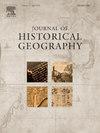Surviving the agricultural periphery: Climatic resilience and livestock production in pre-industrial central Scandinavia
IF 1.3
2区 历史学
Q2 GEOGRAPHY
引用次数: 0
Abstract
This article examines the climatic resilience of farms in Jämtland and Västernorrland in northern Sweden during the crucial period of agricultural transformation in the late eighteenth and nineteenth centuries, with a particular focus on livestock production. Until recently, detailed studies of the impact of climatic change and variability on livestock-oriented regions has been lacking. This article presents a large dataset of livestock production, comprising almost 30 000 tithe observations, the vast majority at the farm level, spanning the period 1582 to 1858, with a particular focus on the peak period of the agricultural transformation around 1770–1840. Food from livestock, mainly milk and its derivative products, is shown to have constituted almost three-quarters of overall food production in the region. Livestock numbers fluctuated not only with household size but also with barley harvests, demonstrating the inherent interdependence of livestock and crops in the mixed farming system of the region. The primary climatic factor affecting livestock numbers from year to year was the temperature during the growing season of the preceding year. This influence predominantly stemmed from the impact of growing season temperatures on meadow growth and arable crop yields. During the period 1770–1840, grain harvest failures only had a marginal effect on the size of subsequent livestock herds, and in several years of harvest failure, livestock numbers could be maintained, demonstrating that livestock could act as a one-year buffer to climatic shocks. After 1773, agricultural improvements helped to mitigate the effects of slumps in agricultural production on subsequent mortality levels.
在农业边缘生存:工业化前斯堪的纳维亚中部的气候恢复力和畜牧业生产
本文考察了在18世纪末和19世纪农业转型的关键时期,瑞典北部Jämtland和Västernorrland农场的气候适应能力,特别关注畜牧业生产。直到最近,还缺乏关于气候变化和变率对畜牧地区影响的详细研究。本文提供了一个畜牧生产的大型数据集,包括近30,000个十分之一的观察结果,绝大多数在农场层面,跨越1582年至1858年,特别关注1770-1840年左右农业转型的高峰时期。来自牲畜的食物,主要是牛奶及其衍生产品,显示占该区域粮食总产量的近四分之三。牲畜数量不仅随家庭规模而波动,也随大麦收成而波动,这表明该地区混合耕作系统中牲畜和作物的内在相互依存关系。每年影响牲畜数量的主要气候因素是前一年生长季节的温度。这种影响主要源于生长季节温度对草甸生长和可耕地作物产量的影响。在1770-1840年期间,粮食歉收对随后的畜群规模的影响很小,在歉收的几年里,牲畜数量可以保持不变,这表明牲畜可以作为气候冲击的一年缓冲器。1773年以后,农业的改进有助于减轻农业生产下降对随后死亡率水平的影响。
本文章由计算机程序翻译,如有差异,请以英文原文为准。
求助全文
约1分钟内获得全文
求助全文
来源期刊

Journal of Historical Geography
Multiple-
CiteScore
1.50
自引率
10.00%
发文量
53
期刊介绍:
A well-established international quarterly, the Journal of Historical Geography publishes articles on all aspects of historical geography and cognate fields, including environmental history. As well as publishing original research papers of interest to a wide international and interdisciplinary readership, the journal encourages lively discussion of methodological and conceptual issues and debates over new challenges facing researchers in the field. Each issue includes a substantial book review section.
 求助内容:
求助内容: 应助结果提醒方式:
应助结果提醒方式:


